
16-17 October 2015. In 1813 in the land of Nubia a boy living on the banks of the Nile showed Jean-Louis Burckhardt, the Swiss explorer, some colossal rock heads protruding from the sand. Burckhardt told his friend Giovanni Belzoni, and in 1817 Belzoni began excavating the site. One of these two explorers named the site for the young boy. The original name of the site is unknown, a chimera, lost to history.
The boy’s name was Abu Simbel.
What Belzoni uncovered is two immense temples cut into the cliff face that rival the greatest of the monumental temples of the world. The temples are man-made caves, and the sheer size is breathtaking. The façade of the Great Temple, dedicated to Ra-Horakty, Ptah, Amun-Ra, and the deified Ramses II, is thirty metres (100ft) high, the height of a ten-story building, and thirty-six metres (119ft) wide. Four colossi of Ramses II, known as the Great, seated on his throne, flank the entrance, two on either side.
The Small Temple is twelve metres (40ft) high and twenty-eight metres (92ft) wide. It is dedicated to the goddess Hathor and to Nefertari, Ramses’ primary wife. There are six colossi flanking the entrance, four of Ramses and two of Nefertari. They are ten metres (33ft) high.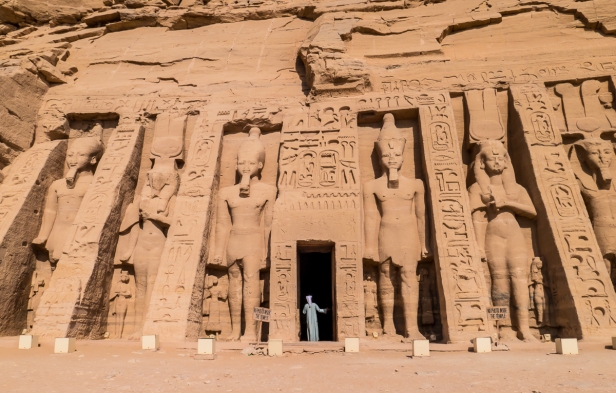

With the construction of the Aswan High Dam and the expected subsequent flooding of the land above it, a heroic mission was carried out. Sponsored by UNESCO, the Government of Egypt, and many other nations, and at a cost of US$40 million, between 1964 and 1968 both temples were dismantled, cut into thousands of pieces and moved up onto the plateau of the cliffs they once sat below. The exact orientation was maintained, and a man-made mountain was created to give the impression of the temples being cut into the cliff.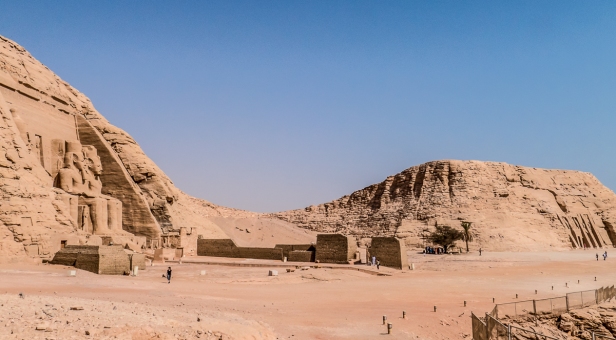
More than three thousand years ago Ramses the Great had the temples built on a site that had long been sacred. It’s likely he chose this site to promote his status as a god among gods and to display his power and omnipotence to the people of Nubia.
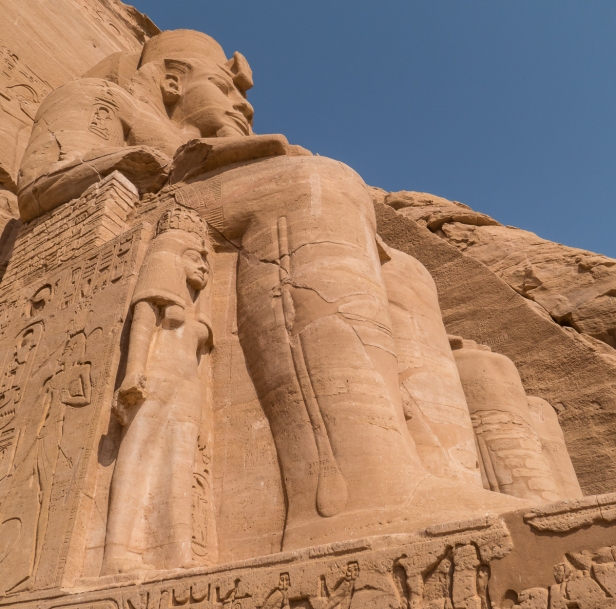
Ramses dedicated the Great Temple to Amun-Ra and Ra-Horakhty. Amun is the king of the gods and Ra is the sun god. Horakhty (Horus) is the god of the sky. And then there’s Ptah, the god of creation. In the innermost temple these gods are seated – the god of the sun combined with the god of the sky (Ra-Horakhty), the god of the sun combined with the king of the gods (Amun-Ra) and the god of creation (Ptah). And there sits Ramses, depicted as an equal amongst them. The hubris, the audacity, is breathtaking, but it is the way of kings throughout time, and is a part of what makes them kings. My favourite description comes from Rough Guides: unabashed megalomania.
The alignment of the Great Temple is such that on the 22nd of February and the 22nd of October every year the morning sun streams in along the main entrance hall all the way into the innermost sanctuary and lights up the statues of Ramses and Amun-Ra.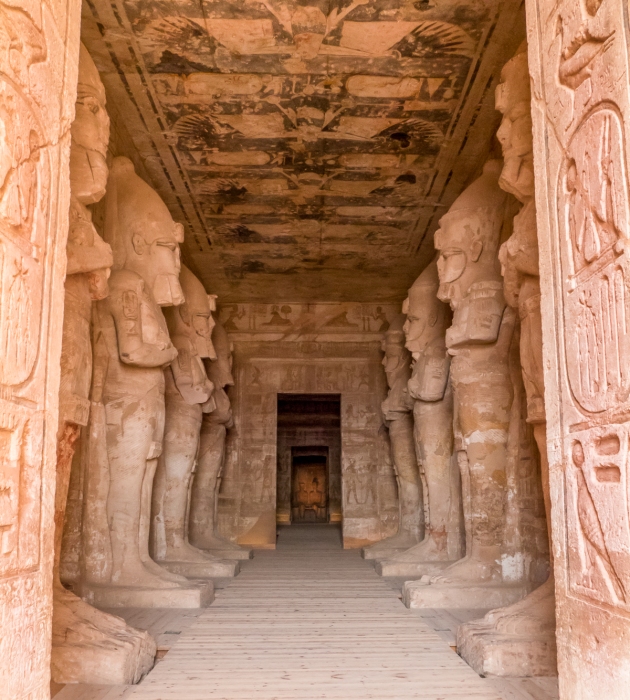
Beyond the entrance there are a series of decorated halls. As I explore the halls I feel a visceral reaction. There are painted relief carvings of the king on every wall. We see him engaged in warfare, smiting his enemies, riding his chariot, and making offerings to his gods.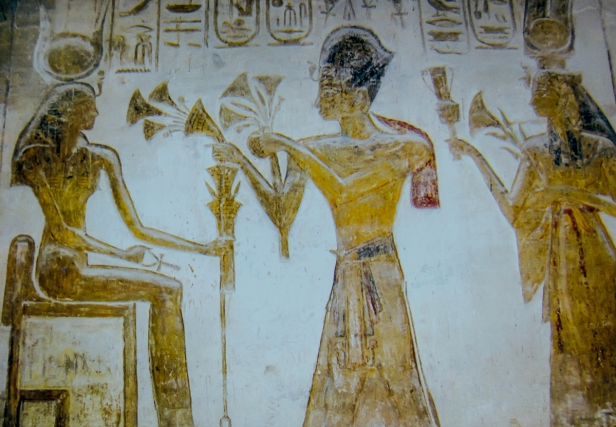
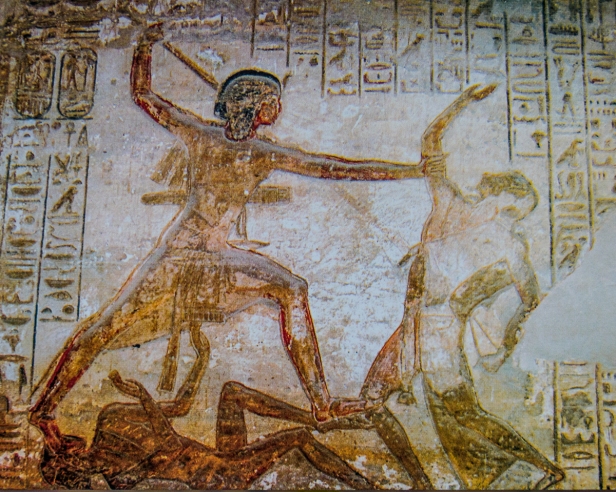
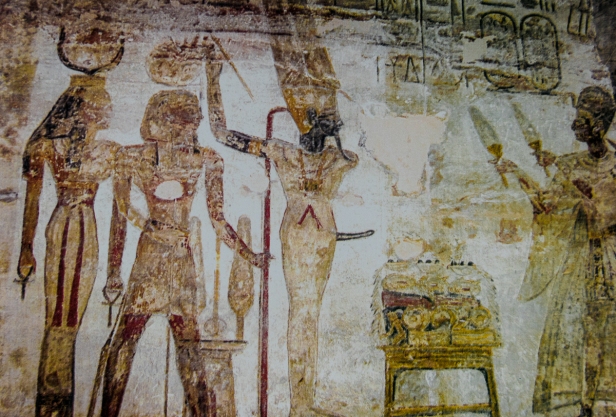


As I go from room to room the feeling grows. Is it that I’m feeling the years of devotion of the king and his priests? Is it the devotion of those who built the temple, carved it into the mountain, and carved and painted the relief carvings that cover every wall? Is it that I’ve been here in another lifetime? Is it the devotion I’m feeling of all the people from so many different nations who cared enough to contribute to moving the entire temple to higher ground so it would be preserved for everyone? Is it that I’m finally here in this astonishing and magnificent place that I learned about so long ago? Is it all of the above? I don’t know. I do know that I’m in tears from the feeling that wells up inside me being surrounded by this genius of creative beauty over three thousand years old. I am undone with the power of this place. I wander from room to room taking in the painted reliefs, glad to be here and surprised by how moved I am. I would love to be able to spend the night here.
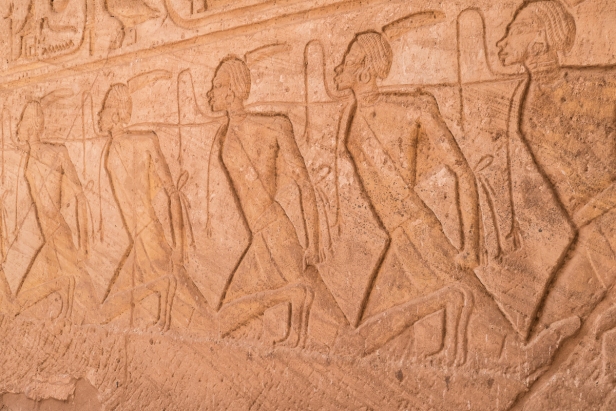
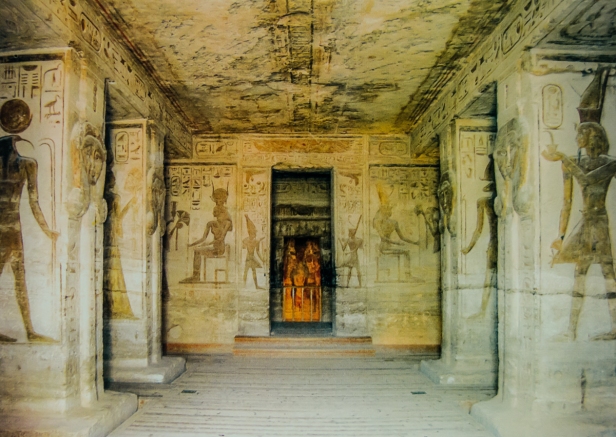
Like all the ancient Egyptian temples the exteriors of these temples would have been brightly coloured. This painting, by noted Egyptian artist Hussein Amin Bicar, captures something of the Great Temple’s original splendour. Unabashed magnificence!
On a more prosaic note, Sapper I.R.W. Beal of the Royal Engineers left his mark on the leg of one of the monumental statues of Ramses way back in 1892. 
We flew to Abu Simbel from Aswan. We had some spare time at the airport waiting for the flight back. I noticed about twenty large potted plants scattered throughout the airport lounge. They clearly had not been watered in a long time and were wilting in the heat. I amused myself by repeatedly filling my water bottle in the bathroom and watering all the plants. Some things just cry out to be done.
In high school I learned that the Egyptians made paper from the papyrus plant, and that the English word paper came from this source. It puzzled me. How could you make paper from a plant? In Aswan I got the answer in a demonstration.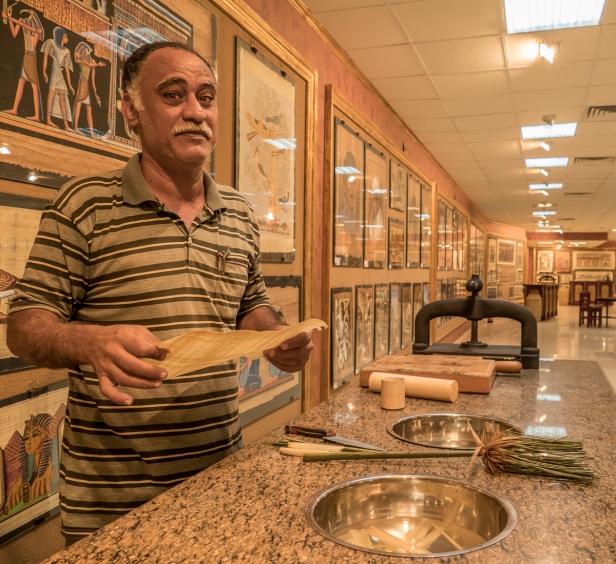
Papyrus has been growing on the banks of the Nile for more than 5000 years. The tougher flexible outer part of the stem is cut off and used for making mats. The core of the stem, which is less flexible and can be easily broken, is cut into thin slices lengthwise and rolled flat to remove any excess liquid. This makes it strong and flexible. It is then soaked in water for six days. These strips are then laid flat in a weaving pattern – one down, one across and so on. The piece of paper is then put under a press for 6 days. Fake papyrus paper shows the joins going in only one direction and is made from sugar cane or some part of the banana palm.
So all of this needs to be discovered: that if you take the core of the stem of a papyrus frond, not the stem, or the leaves, but the core of the stem, slice it thin lengthwise, roll the strips flat, soak them in water for six days, lay the strips together in a weave pattern, and then press the whole thing for another six days you will then come up with something you can write on. How would you discover that? Who would discover that? Human ingenuity and creativity continues to amaze me.
About fifty kilometres down river from Aswan is the temple of Kom Ombo.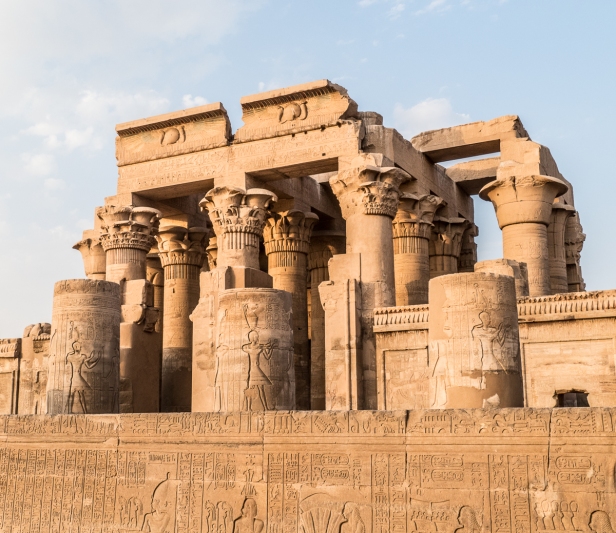



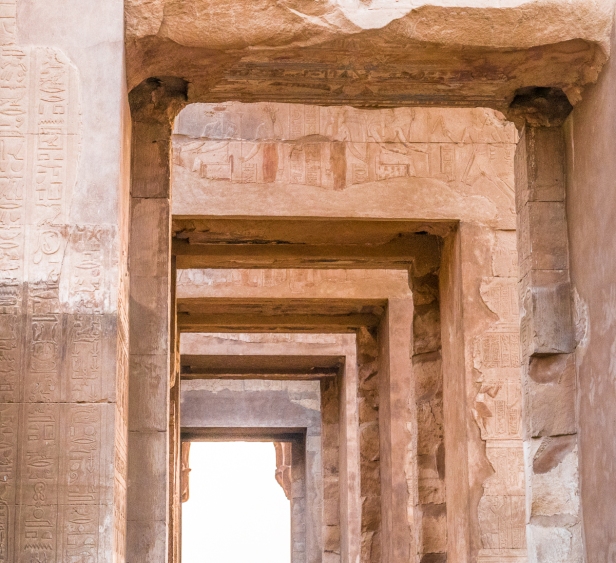
It’s a double temple dedicated to Horus the falcon-headed god and his enemy Sobek, the crocodile god. Sobek was viewed as a creator god and master of the universe.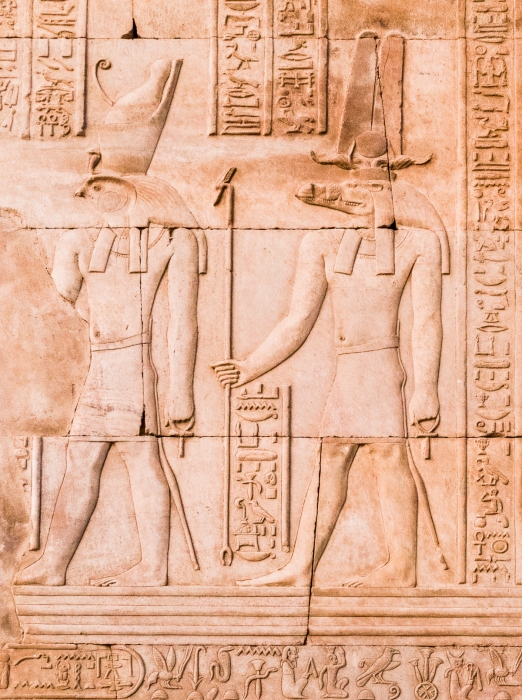
Yes, the Egyptians had a crocodile god. A captive crocodile was kept within the temple and believed to be an earthly incarnation of Sobek himself. After its death it was mummified, and buried with much ceremony. There is a crocodile cemetery close to this temple that yielded vast numbers of crocodile mummies. The priests would then identify a new crocodile to be host to the divine spirit of Sobek.
From a sign at the crocodile museum: The ancient Egyptians believed that the gods sent physical manifestations of themselves to earth in the form of their totemic animals. Thus at Sobek temples a live crocodile was thought to contain a spark of the god within and was worshipped and cared for by the priests during its lifetime. After its death the spirit of the god would move to another crocodile’s body.
Apparently, when there were still crocodiles in the Nile north of the Aswan Dam, quite a number of them liked to gather in this area, and no doubt more than a few people over the years were croc dinner. It is not surprising that the people went in fear. They hoped that by honouring the crocodile as a god they would be safe from attacks.
The Nile crocodile is the most dangerous of all the crocodilians. They can reach up to six metres (20ft) in length and have a fiercely strong jaw. Once it clamps onto something it’s impossible to get it to let go. It is an opportunistic ambush predator, and can take down everything from a hippopotamus to a human. Living by such a creature I think I’d be praying to its god too.
There were healing priests at this temple and it was a place of pilgrimage for people who were ill. This ancient graffiti possibly shows the name and date of a person who came for healing. I guess we all like to leave our mark.
We’d travelled to Kom Ombo from Aswan by boat. After nearly three days in Aswan we began a three-day journey down the Nile to Luxor on a luxury cruise boat. Next post: the Nile cruise.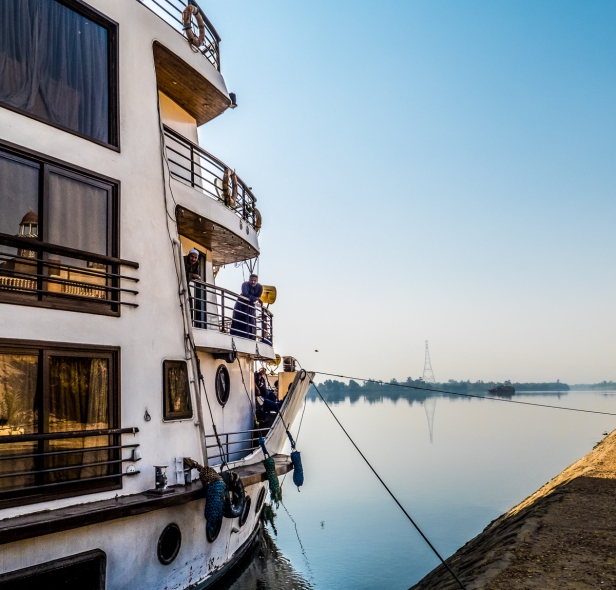
Note: No photographs are allowed inside Abu Simbel. All interior shots and the opening shot are photographs of photographs that I bought at the site.
All words and images by Alison Louise Armstrong unless otherwise noted
© Alison Louise Armstrong and Adventures in Wonderland – a pilgrimage of the heart, 2010-2016.

Now that’s a great walk through history. 🙂
LikeLiked by 1 person
Thanks Paulette. It was wonderful going back in time in Egypt.
Alison
LikeLike
Great photos, and many thanks for sharing pics of the interior and an aerial pic.
LikeLiked by 1 person
Thanks Peggy. I quite often take photos of postcards if no photography is allowed. It helps me remember.
Alison
LikeLike
First of all I cannot believe the great condition of all these relics and temples – it is simply astounding. Secondly I, like you, would be moved to tears…and for all the same reasons you mentioned. You are so fortunate to have this experience, and in your next lives you will be far wiser for it, I am sure. Those who are blessed with the opportunity to wander and learn in this current life, I happen to believe, are meant to be the prophets of the future and the knowers. Sending lots of love – jo
LikeLiked by 1 person
I know how incredibly lucky I am – to finally get to Egypt! It has lived in my psyche for fifty years since I first learned about it in school. Going to these sacred places felt like going home, like I belonged there. I’m sure I lived then. I had an even stronger reaction in the tombs in the Valley of the Kings. I do agree with your last sentence.
love right back to you.
Alison
LikeLiked by 1 person
Great stuff as usual.
Thanks for these journeys.
Keith
________________________________
LikeLiked by 1 person
Thanks so much Keith. Glad you’re enjoying our journey in Egypt.
Alison
LikeLike
Beautiful post, Alison. Makes Mt. Rushmore seem sort of trivial, or passé. The Egyptian history is always sort of enthralling to me, but I don’t read much about it on my own and just have those glimpses from the museum we went to once when the Egypt exhibit came through, and the third grade dioramas we made. I can understand your tears. One of my favorite recordings to listen to is Gabrielle Young reciting translations of Egyptian Pyramid Texts, on her CD Sea of Splendor. There is just something about it… (http://gabrielleyoung.com/cds/)
Paper is always amazing to learn about, isn’t it? I have done some work on the periphery of paper mills over the years, and have walked through a few of them and stood with my chin hanging loose as rolls fifteen feet wide orbit metal rollers six feet in diameter, six or seven in a row, and fly at what looks like ten or fifteen miles per hour onto a big spool. It’s basically the same as you saw, though chemically and energetically enhanced– wood fibers made into mush and dried flat…
Unabashed megalomania. Yes. If our politicians turned their aims to producing beautiful cultural icons, it would at least be more fun!
Peace
Michael
LikeLiked by 1 person
Thinking of any politician in particular?
LikeLike
Well it is certainly easy to narrow down the search these days, particularly here in the US, Don! But I think we may be leaving a few choice selections out in the heat of the moment. 🙂
LikeLiked by 1 person
Thanks Michael. I was not familiar with Gabrielle Young. I’ve been searching. I can only find videos of her reciting Rumi. I”d love to hear the Egyptian texts but at least I could read this piece on her site.
I walk on earth beneath blue heaven,
my heart telling the story of light;
I walk in harmony,
heaven in one hand, earth in the other;
I am the knot where two worlds meet.
Rejoice! Let grace roll down your cheeks like water;
you are crystal reflecting fire,
In your own becoming
there is Light enough to lead you home;
Go, then, blue-lidded daughter of Dawn, go,
and make of the world something beautiful.
The line ‘Let grace roll down your cheeks like water’ – is exquisite.
So that led me to Normandi Ellis’ Awakening Osiris: the Egyptian Book of the Dead, which I’d never heard of – and the little I know of the religion, the mysticism, of ancient Egypt suddenly becomes more real.
Wood fibres made into mush and dried flat – that’s about it. I guess we discovered that a really really long time ago.
Alison
LikeLiked by 1 person
Awesome photos Alison and amazing experience !
LikeLiked by 1 person
Thanks Cindy. It really was an amazing experience. One I’ll never forget.
Alison
LikeLike
What a story, Alison — in so many ways. Really compelling how moved you were while inside the temple. I love your introspection about the reasons why. And I love that you watered the plants!!! You are a such kind and compassionate soul. 🙂
LikeLiked by 1 person
Thanks Kelly. I didn’t expect to be so moved at Abu Simbel. I was again also in the tombs in the Valley of the Kings. I’m sure I’ve been there before. I think ancient peoples had a better connection to the earth, and therefore a better connection to spirit than we do now. There’s something so powerful about these places.
Those plants were pretty loud – pay attention to me now!
Alison
LikeLike
I find when I read your posts I’m not even sure where to start. It could be the fabulous photos, it could be your eloquent telling of the story, your thorough historical research but truly it’s the sharing of how the experience made you feel that really touches my heart. Wow!
LikeLiked by 1 person
Thanks so much Sue. Abu Simbel was an unexpectedly powerful experience. I’m glad I was able to convey something of that.
Alison
LikeLiked by 1 person
I am amazed once again. I love all the history and the photos. What an experience it must have been. Thank you for sharing it!
LikeLiked by 1 person
Thank you so much. Egypt was one of the best travel experiences ever!
Alison
LikeLiked by 1 person
Yet another brilliant post Alison! Somehow after reading one of your posts it takes me a while to snap back to reality. I honestly feel like I have been transported to these places and need a minute to re-orient myself 🙂 The pictures as always are stunning. And your vivid descriptions… Sigh! Now I need to get myself to Egypt 🙂
LikeLiked by 1 person
Thanks so much Diya. I’m glad you got carried away to Egypt 🙂
I hope you get there one day. It really is amazing.
Alison
LikeLiked by 1 person
Alison,
I think, in order to feel, one has to know and to know, one has to feel. I think you possess this gift in abundance and indeed, the very reason why you move people to travel alongside you in such awe.
Reading this particular piece of your genius, it is obvious to me the humongous amount of work and dedication you must have attributed beforehand in order to learn the very complex names and associations of these bigger than life characters. Very rarely does an average traveller go to such depths and to recognise the contribution of past civilizations to our present.
I have travelled down the Nile where the papyrus has choked the river to a point of strangulation and I never associated it to paper making nor did I know the origins of the word ‘paper’ . Thank you for enlightening me and thank you for your hard work.
mashoud
LikeLiked by 1 person
Thank you so much Mashoud. What a wonderful compliment. I do feel deeply. I’ve come to value it though that was not always so.
I’ve been drawn to the ancient Egyptian culture since early adolescence, but my knowledge was quite general. It’s only through writing these posts that I dig deeper – so that way I get to go on the journey all over again. I feel as if it lives in me somehow.
For some reason I never forgot the school lesson about the origins of the word paper even though it was about 50 years ago now. It was fascinating for me to finally see how paper was made from papyrus.
Alison
LikeLike
Really stunning post Alison and wonderful photos. I’m glad you posted ones of the interior as I’d almost forgotten what it’s like.
LikeLiked by 1 person
Thanks Emily. Your own photos are not too shabby either. It’s an amazing place isn’t it!
Alison
LikeLiked by 1 person
It’s fabulous and I’d love to go back one day.
LikeLiked by 1 person
A fascinating read which brought the temples to life for those of us who haven’t been fortunate enough to visit yet. The scale and beauty of them never ceases to amaze! Thank you for another wonderful post.
LikeLiked by 1 person
It was amazing to be there. The scale is astronomical! I guess that’s what unabashed megalomania does. I hope you get there one day 🙂
Alison
LikeLiked by 1 person
Absolutely magnificent and totally awe-inspiring. And what a monumental project to move and re-construct all those thousands of pieces!! A fantastic article, as always, with great photography. Love to you both.
LikeLiked by 1 person
Thanks Isabellarose. I was so moved that people cared enough to save them, no matter the cost. Abu Simbel was an amazing experience for me, totally awe-inspiring.
Alison xox
LikeLiked by 1 person
I am truly enjoying your series on Egypt, Alison— your photos, history, mythology, and personal experiences. BTW, I’v always like Hathor and her beginnings as the cow goddess. –Curt
LikeLiked by 1 person
Thanks so much Curt. It was an amazing journey in so many ways. I guess I could have written a bit more about Hathor the cow goddess. I think she comes up in other sites we visited.
Alison
LikeLike
🙂 Where are you guys hanging now?
LikeLiked by 1 person
We’re in Vancouver for a few months. Not sure about our next move yet.
LikeLiked by 1 person
Alison, this fascinating post and beautiful photos further entice my desire to visit Egypt. – Ginette
LikeLiked by 1 person
Thanks so much Ginette. I hope you get to Egypt one day!
Alison
LikeLiked by 1 person
I always try to imagine the sheer wonder and awe of the early explorers who “discovered” these ancient religious sites and the excitement of the excavators as they uncovered the colossal statues and brushed the sand of the ages from carvings and paintings. How wonderful that so many nations worked together to dismantle and move the temples so that present day adventurers and wanderers can experience the beauty and be moved by the creative genius (and egos!) of those who worshiped and walked among these ancient gods. A great post Alison! Anita
LikeLiked by 1 person
It would have been amazing to be one of those early explorers or excavators! I can hardly imagine how exciting that would be. I’m sure part of my emotional reaction inside Abu Simbel was because people cared enough to save it. We seem to dwell far too much on the ‘evils’ of humankind, but there is so much good in the world, so much caring and creativity. Enough to spend $40 million to save a great ancient treasure. Thanks Anita.
Alison
LikeLike
Wow Alison. The scope of these treasures is just amazing. I loved seeing the people as mini-beings next to the massive sculptures. And the details…wow. Susan
LikeLiked by 1 person
Isn’t it incredible! I was blown away learning about it, but to finally see the real thing was definitely a peak experience. The details in the paintings is amazing. I’d kind of like to see some of them fully restored to get a better idea of what they were like at the time. I bet they glowed!
Alison
LikeLiked by 1 person
I can’t fathom moving all those carvings! Or for that matter, how they were even done in the first place so long ago. What riches are in Egypt and how I’d love to go … you are indeed lucky to have made it to a place that lived inside you for so long. I think it’s that connection to past learning or yearning that gives us the goosebumps once we finally get somewhere like this. I know I feel things deeply like that, as you do. Truly the joy of travel.
LikeLiked by 1 person
I do think you’re right about the connection to past learning – it seems I always feel more deeply in places I’ve longed to experience since my youth – Egypt and Burma come to mind. But it’s not always true for me. I learned as much about the ancient Roman Empire in school as I did about the Egyptian but it is ancient Egypt that really speaks to me, hence my thinking there is past life experience. Abu Simbel was not the only place there that affected me deeply. And yes, I feel so so lucky to have finally gotten there. What a blessing. I think I didn’t really realize how much I’d been yearning for it until I was finally experiencing the reality.

I was totally blown away by the whole project of moving the temples. There are images online of huge cranes lifting enormous blocks of stone. There’s one of a crane lifting one of the faces of Ramses which really gives an idea of the scale. I still can’t fathom how they did it.
Alison
LikeLike
worthy of being preserved
for the ages on papyrus
and kept from hungry jaws
of 20 foot beasts 🙂
LikeLiked by 1 person
Yes indeed so glad
preservation efforts
allowed a teary visit
45 years after I first learned
of this ancient wonder.
Crocodile mummies a
complete surprise!
Alison
LikeLike
What a magical read this is! The Egyptians are so different from us in their outlook and yet so captivating. I looked at that cruise boat in your overhead, Alison, and it certainly brings it all into scale. The one I found hardest to look at is the brightly coloured image. We are so used to seeing the buildings and paintings in antiquity. I can see why the whole experience would move you. So very beautiful! 🙂
LikeLike
Thanks so much Jo. I haven’t been ignoring you. I found you in spam! It’s a good thing I read through spam entries before deleting them. Every now and then I find one that’s a legit comment.
The scale is quite breathtaking. I guess that’s what unabashed megalomania does.
I must admit that if I were doing a painting of what the entrance to the temple would have looked like I would not have chosen those colours. In my mind it is more cream/yellow and less orange. I’d love to have seen the Egyptian temples when they were all shiny and new – but then again perhaps I did 🙂 and perhaps that’s why I was so moved. It was a really special experience. All of Egypt was special.
Alison
LikeLike
Hooray, I’ve been rescued again! 🙂 🙂 I seem to’ve hidden in a few spam folders lately, Alison. I’m starting to feel like the Invisible Woman.
LikeLiked by 1 person
I’m glad I found you 🙂
A.
LikeLiked by 1 person
Alison, like those who have commented above, your post has me yearning to go and experience Abu Simbel for myself! Before reading this, I did not know how the temples got their name. What a triumph of modern engineering that these wonders were dismantled stone by stone and carefully reassembled on higher ground – I had to look very, very closely at your photos to see the lines where they were cut into massive blocks.
As always, your storytelling took us on a wonderful inner and outer journey. I loved how you could pinpoint the reasons behind your emotional reaction inside Abu Simbel. It amazes me to no end how the architect designed the temple so the morning sun would light up its innermost chamber twice a year… it’s said that one of those dates corresponded to Ramses II’s birthday and the other was his coronation. The man was clearly a megalomaniac!
The 19th-century graffiti from that sapper was quite jarring – the writing seems so banal and crude in comparison to the magnificence that surrounds it. Your commentary about the crocodile god gave me a chuckle. I remember reading about cat mummies as a child… do you know if there was an Egyptian cat god as well?
LikeLiked by 1 person
Thank you so much James. Abu Simbel was an astonishment for me on so many levels and for so many reasons. That they saved it! That they *could* save it! The scale and design of the temple! The hubris of the king! And my feeling that I’d been there before. It all added up to a powerful experience. I didn’t know how it got its name either until I researched for this post. And I knew nothing about the crocodile god, or the croc mummies until we arrived at the temple. Bastet was originally a lioness warrior goddess of the sun but later was changed into the cat goddess, and yes there are cat mummies tho I didn’t see any.
Alison
LikeLiked by 1 person
I don’t even know where to start Alison. I do know that I have saved this post until I had some quiet time to really absorb it. Your ability to relive history through your words never fails to astound me. Not only do I learn so much but I feel like I’m being drawn back through the years to a time and place that seems so foreign yet so familiar. Your ability to make me feel deeply always comes through in your writing, There is an easy eloquence and a spiritual aspect that I am drawn to, particularly through your questions as you seek to understand your own emotions. Now for your photos…all of them, wow! However, there are three in particular that really spoke to me. The first is the shot of the main entrance hall into the inner sanctuary, that the sun filters into twice a year; the second is the many doorways that you captured; and the third is your final image of the ship with its reflections and the two inquisitive passengers. This was truly a joy to read!
LikeLiked by 1 person
Thank you so much LuAnn for your wonderful compliments. Thank you. I’m glad the post speaks to you so vividly. Abu Simbel was a very powerful experience for me, a stand-out in the whole Egypt journey that was itself a powerful experience. Those are three of my favourite photos too, though I must let you know that the inquisitive passengers are actually crew. That ship photo is a huge favourite of mine. I was so pleased with how it turned out.
Alison
LikeLiked by 1 person
You do such a wonderful job with image composition. 🙂
LikeLiked by 1 person
I quite like the first picture where we can see it from above because I’ve never realised it was so close to the water. Egypt is a fascinating country and I remembered reading so many books from Christian Jacq when I was younger, with all the mysteries around the pharaoh etc. Just looking at your pictures makes me want to go there at one point !
LikeLiked by 1 person
I saw a video about the reconstruction that showed where it was originally located way below, though not directly below but a bit to the left of the picture. I didn’t mention this in the post but apparently the sunlight streamed in on the 21st of Feb and Oct but with the relocation they were out by one degree which change the date to the 22nd. I was not familiar with Christian Jacq – a quick google search – those Ramses mysteries sound amazing. Go to Egypt! It won’t disappoint. It is one of the highlights of all our travels.
Alison
LikeLiked by 1 person
Oh I see ! Thanks for the explanation.
Christian Jacq is mixing a bit of facts and a lot of fantasy in his novels but the result is quite good. When I was a teenager, I really enjoyed them. You could learn history in a funny way 🙂 I was able to name all the pharaohs but now I’ve forgotten everything :p
I would also love to visit Egypt for the diving aspect. People say they have done their best dives over there.
LikeLiked by 1 person
I’ve heard that about the diving – at Sharm el-Sheik. Even tho a Russian plane was shot down over the Sinai we heard that there’s a wall of protection around the dive resorts.
A.
LikeLiked by 1 person
I think they try to keep it safe as it is good revenue for them.
LikeLiked by 1 person
Yes, it must be. Egypt is desperate for tourists so this is one place where some are still going tho the downed Russian plane probably didn’t help.
LikeLiked by 1 person
Absolutely amazing Alison! Wow!!!
LikeLiked by 1 person
Thanks so much Nicole. Egypt is one of the most amazing places we’ve been to.
Alison
LikeLiked by 1 person
Such a huge list Alison for me! So many places to go! I truly admire the work you put into your posts. Each one is so incredibly well written with such detail and so beautifully photographed. I appreciate all the hard work you put into your amazing content!
LikeLiked by 1 person
Oh I know what you mean – our list seems to get longer with the more travel we do, not shorter. Thanks so much for your kind words Nicole. It’s a labor of love that’s for sure.
Alison
LikeLiked by 1 person
I had no idea that Abu Simbel was named for the boy who first told the explorers where to look. I really like that!
And of course, the story of how it was dismantled and moved is just incredible. Humanity has some pretty awful bits to it, but things like this highlight the huge feats we can be capable of.
As for the papyrus, it’s mind-boggling to imagine how each step in the paper making process was discovered. It must’ve taken so long to string together that complicated succession of tasks! I don’t think I’ve ever actually touched papyrus, just seen a scroll or two written on it behind glass in a museum. Did you get to touch any of the papyrus you saw being made?
LikeLiked by 1 person
I had no idea about the name of Abu Simbel either. I was really tickled by it. Here I was thinking it was some accurate ancient name, but no, just the name of a young boy of the 1800’s. I’ve watched some videos about moving Abu Simbel – it was truly an astounding engineering feat.
I didn’t touch the papyrus! Of course now I wish I had. It looked quite flexible, so I’m imagining a kind of roughish finish but still pliable.
Alison
LikeLike
adds much to my wonders of his/herstory…the details are outstanding…love tour posts and as others yearn to leave…updating passport this week! ☺️
LikeLiked by 1 person
Thank you so much Hedy. Egypt was a magical unfolding for me – many his/herstories of wonderment. What a civilization it was! Take that passport on a journey 🙂
Alison xo
LikeLiked by 1 person
Oh I hope too travel more and more…I get that run away feeling more now than ever before…passport for 10 years now ☺️
LikeLiked by 1 person